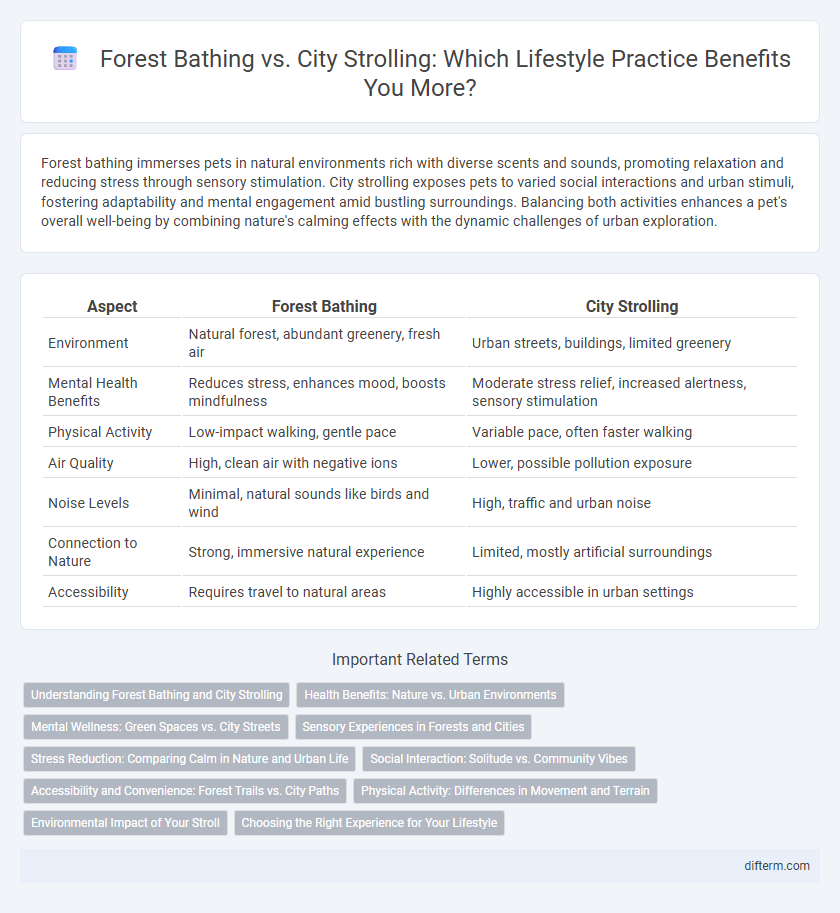Forest bathing immerses pets in natural environments rich with diverse scents and sounds, promoting relaxation and reducing stress through sensory stimulation. City strolling exposes pets to varied social interactions and urban stimuli, fostering adaptability and mental engagement amid bustling surroundings. Balancing both activities enhances a pet's overall well-being by combining nature's calming effects with the dynamic challenges of urban exploration.
Table of Comparison
| Aspect | Forest Bathing | City Strolling |
|---|---|---|
| Environment | Natural forest, abundant greenery, fresh air | Urban streets, buildings, limited greenery |
| Mental Health Benefits | Reduces stress, enhances mood, boosts mindfulness | Moderate stress relief, increased alertness, sensory stimulation |
| Physical Activity | Low-impact walking, gentle pace | Variable pace, often faster walking |
| Air Quality | High, clean air with negative ions | Lower, possible pollution exposure |
| Noise Levels | Minimal, natural sounds like birds and wind | High, traffic and urban noise |
| Connection to Nature | Strong, immersive natural experience | Limited, mostly artificial surroundings |
| Accessibility | Requires travel to natural areas | Highly accessible in urban settings |
Understanding Forest Bathing and City Strolling
Forest bathing involves immersing oneself in a natural woodland environment to reduce stress and enhance mental clarity through sensory engagement with trees, plants, and fresh air. City strolling offers dynamic exposure to urban landscapes, combining physical activity with cultural stimulation, social interaction, and varied sensory inputs like architecture and street sounds. Both practices promote well-being but engage different aspects of sensory and cognitive experiences rooted in nature versus urban settings.
Health Benefits: Nature vs. Urban Environments
Forest bathing enhances mental clarity and reduces stress by immersing the body in phytoncide-rich air, which boosts immune function and lowers cortisol levels. City strolling offers cardiovascular benefits and increased social interaction but often exposes individuals to higher pollution and noise, potentially negating some health gains. Natural environments are scientifically proven to improve overall well-being more effectively through enhanced mood regulation and cardiovascular health compared to urban settings.
Mental Wellness: Green Spaces vs. City Streets
Forest bathing immerses the mind in natural surroundings, reducing cortisol levels and enhancing mood through exposure to phytoncides and natural sounds. City strolling engages the brain with urban stimuli, which can both stimulate cognitive function and increase stress due to noise and crowds. Access to green spaces consistently correlates with lower anxiety and improved overall mental wellness compared to prolonged exposure to city streets.
Sensory Experiences in Forests and Cities
Forest bathing immerses individuals in natural environments, enhancing sensory experiences through the sounds of rustling leaves, fragrant pine, and the tactile feel of moss-covered bark. City strolling stimulates the senses with a dynamic blend of urban sounds, diverse smells from street food and exhaust, and vibrant visual stimuli from architecture and crowds. Both settings engage smell, sound, and touch uniquely, influencing mood and mindfulness in distinct ways.
Stress Reduction: Comparing Calm in Nature and Urban Life
Forest bathing immerses the senses in natural surroundings, promoting significant stress reduction through exposure to phytoncides and the calming effects of green spaces. City strolling, while also offering mental breaks, tends to provide less profound relaxation due to noise, pollution, and sensory overload. Studies show that time spent in forests lowers cortisol levels more effectively than urban walks, making forest bathing a superior choice for reducing stress and enhancing overall well-being.
Social Interaction: Solitude vs. Community Vibes
Forest bathing promotes solitude and mindfulness by immersing individuals in quiet natural surroundings, fostering deep self-reflection and stress reduction. City strolling encourages social interaction and community vibes through encounters with diverse groups, street performers, and vibrant urban life. Choosing between the two depends on whether one seeks peaceful isolation or energetic social engagement for mental well-being.
Accessibility and Convenience: Forest Trails vs. City Paths
Forest trails offer immersive nature experiences but often require travel time and may have uneven terrain, limiting accessibility for some individuals. City paths provide convenient access with paved walkways, public transportation options, and proximity to urban amenities, making daily walks easier to integrate into busy lifestyles. Urban environments also enable flexible schedules, allowing people to enjoy strolls without significant planning or travel.
Physical Activity: Differences in Movement and Terrain
Forest bathing involves slow, mindful walking on uneven, natural terrain, promoting balance and proprioception through varied surfaces like soil, roots, and rocks. City strolling typically features more consistent, flat surfaces such as sidewalks or paved paths, enabling a steadier pace and less intense physical engagement. The varied movement patterns in forest bathing offer enhanced sensory stimulation and physical challenges compared to the repetitive, low-impact nature of city walking.
Environmental Impact of Your Stroll
Forest bathing significantly reduces environmental impact by promoting conservation and minimizing urban pollution exposure, whereas city strolling often contributes to air and noise pollution from vehicles and crowded sidewalks. Immersing in natural forest environments supports carbon sequestration and biodiversity, contrasting with cities where green spaces are limited and fragmented. Choosing forest trails over concrete pavements encourages sustainable outdoor activities that foster ecological balance and personal well-being.
Choosing the Right Experience for Your Lifestyle
Forest bathing offers immersive nature therapy that reduces stress hormones and boosts mental clarity, ideal for those seeking tranquility and deep relaxation. City strolling provides dynamic social stimulation and cultural engagement, perfect for individuals who thrive on urban energy and exploration. Selecting between these experiences depends on your personal wellness goals and daily routine preferences, ensuring alignment with your lifestyle for maximum benefit.
forest bathing vs city strolling Infographic

 difterm.com
difterm.com